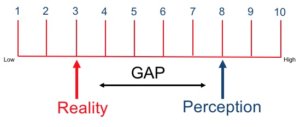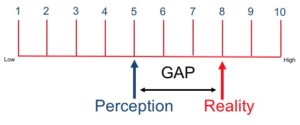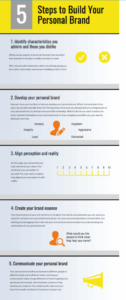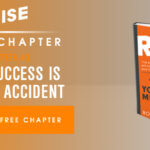
What do you think people are saying about you? Perhaps more importantly, what do you want them to be saying? Today, you can’t leave your personal brand to chance. Businesses and organisations don’t, so why should you? To unlock your real potential you must make it a conscious process to design, build and develop your own compelling personal brand: identifying what you stand for, what you want to be known for and creating an engagement plan for how you are going to market the most important brand asset you own – yourself.
We live in the age of the brand, from the gadgets and devices we use for work and play, to the clothes we wear, the car we drive and the stores we shop in. We make conscious and subconscious choices determined not just by cost, style, and quality but the brand values that underpin those products and organisations. In today’s fast-moving, ever-changing world increasingly we’re seeing the concept of brand extending to people.

When people hear your name, what do they think? What are the characteristics and brand values that immediately come to mind? What’s your personal brand?
If you were being interviewed for a job or pitching to potential clients or about to the close the deal of your life and the individual opposite you suddenly leaned in and said, ‘I’m going to ask one question, why you? How well would you answer that question and with what degree of confidence, clarity, and purpose?
What is personal brand?
At its simplest, your personal brand is how others perceive you. In a professional context, that perception can affect your promotion chances or the likelihood of an application standing out from those of other applicants when you submit your CV or resumé for evaluation. In a personal context, your personal brand will affect the quality of your relationship with your partner, your beliefs and qualities as a parent, your contribution to team sports and how you are perceived as a friend. Yes, your personal brand is that important!
Jeff Bezos, CEO of Amazon famously put it “Your brand is what people say about you when you’re not in the room!” Sometimes wouldn’t you just love to be a fly on the wall and hear what people are saying about you? I know I would.
The powerful but very simple message is that you can greatly influence what others are saying about you by becoming conscious and deliberate in what you want your brand to stand for and making sure that it plays out through your body language, what you say and how you say it.
‘Great person to know…. truly wants to help you get on’
‘The most authentic, real and down to earth person I’ve ever met’
‘Real strong family values’
‘An action orientated person who makes stuff happen’
You get the picture.
It’s your personal brand, it’s about you so make sure people are saying what you want them to say!
5 steps to building your personal brand
Step 1 – Identify characteristics you admire and those you dislike
All day, we see aspects of personal character that we either love and wish to emulate or dislike and wish to avoid: The people…
…in our lives: colleagues, bosses, customers, suppliers, and partners
…we read about or see on TV and on the Internet: celebrities, sports stars and business personalities
…we know deeply, such as family members and friends.
Why reinvent the wheel when others are already giving us live-action case studies and success modelling to learn from?
Brainstorm the personal characteristics you have observed in individuals you admire. Think of the person first and then think about three or four of their personal characteristics, or brand traits, that instantly pop into your mind.
For example, if I said the name Nelson Mandela, what would come to mind?
On my list would be courage, resilience, and humility. This is a man who walked out of prison and said: ‘Hey, I know you locked me up for 27 years, but let’s lead the country together.’ That’s an astonishing statement, which for many was the defining characteristic of this great man.
What brand traits would you use to describe Richard Branson? On my list would be entrepreneurial, risk-taking, visionary and charismatic. How about the singer/songwriter Lady Gaga? On my list would be eccentric, unique, fearless and consistent.
Do you have or want to have any of these characteristics in your own personal brand? Are they what you want to be known for?
Just as importantly, identify the traits you see in others that you do not admire, and that may even repel you. These are traits you would like to explicitly ban from your personal brand. Some will be easy; some you’ll have to really work at.
Brainstorm as many examples as you can of people who display characteristics you don’t like. Use the same categories as before: people in your life, people you have heard of, and people close to you. Who was the worst boss you ever had? Why was that? What was it about them that you disliked, and what do you wish they had done differently?
Step 2 – Develop your personal brand
Now you have your two lists, here’s the fun part: developing your personal brand.
Which characteristics do you feel naturally drawn to? Perhaps they’re ones you already feel are an integral part of your personal brand, or perhaps ones you’d like to develop.
Also, reflect on the characteristics you dislike. What traits do you want to make sure never manifest themselves in your personal brand or, if do you recognise yourself in any, want to eliminate them fast. You know what I’m talking about here: the negative characteristics that you know don’t serve you well but which may keep rearing their ugly heads, tarnishing the way people think of you.
You might have a reputation for always being late for meetings, you rationalise it as being busy, others perceive it as being disrespectful. Or you might consistently over-promise when making commitments. Whilst your intentions are good and you mean well, without realising it you’re giving yourself a credibility problem.
Draw out the key areas you want to focus on (and avoid) in order to build and develop your personal brand. It’s designed to be a fluid, agile process and, most importantly, fun and exciting as you take ownership of building the personal brand that you want to live and be known for.
Step 3 – Sense check perception versus reality
Your list from step 2 is now a good representation of the personal brand you are and the personal brand you want to be. However, at this stage, it really only represents your view of the world and your perception of yourself. You now need to explore how aligned your perception is with reality.
The challenge in seeing the world through only your lens and your eyes is that, depending on your level of emotional intelligence and how honest you are prepared to be, you can end up with what I call reality distortion.
For example, a perception/reality gap could be an individual who has a high perception of their self-worth and brand position, but this is out of kilter with feedback from others. Their self-perception could be an 8 or 9 and reality a 3.

If this were a real scenario for an individual, you would describe them as delusional – clearly so wrapped up in their own internal view of the world that they are just not open to feedback, particularly the kind that might challenge them to change.
Or an individual who perceives themselves at 5, but feedback tells them they’re actually much higher, an 8.

There are two possible ways to interpret this result. The first is that this could be an individual with low self-esteem, self-belief or confidence. The second is that it could be someone who sets extremely high personal standards of excellence and therefore they are always going to score themselves lower than others because of the expectations they place on themselves.
If you are really in tune with who you are, what you stand for, the value you add and the difference you make, where should perception and reality be?
The answer is that they should be aligned: there should not be a gap between perception and reality.
How aligned are their traits with yours? Do perception (your interpretation) and reality (their view) match?
Where are the gaps, the blind spots? What do you need to work on?
Step 4 – Create your brand essence
Your brand essence is your one sentence or strap-line that clearly articulates who you are, what you stand for and what your personal brand is about. You may have several positive characteristics, but defining and packaging those traits into one sentence demonstrates the true understanding and authenticity of your personal brand.
This idea is championed by Daniel Pink, the author of the best-selling book Drive: The Surprising Truth about What Motivates Us and a globally renowned speaker and thought leader. Pink starts by saying that every great person is a sentence.
He tells the story of a congresswoman named Clare Boothe Luce who went to see a young President John F. Kennedy in the early 1960s and said:
‘Mr. President, you don’t understand something significant about leadership. A great person is a sentence. Anyone who has ever achieved anything in their lives isn’t trying to do 97 different things, but one or two big transcendent things. Abraham Lincoln had a sentence. He preserved the Union and freed the slaves. FDR had a sentence. He lifted us out of a Great Depression and helped us win a world war. Mr. President, you don’t have a sentence, you have a muddled paragraph. You’re trying to do 17 things and, as a result, you’re doing nothing.’
What’s your one sentence?
Step 5 – Communicate your personal brand
Communicating your personal brand is most effective when you’re as conscious and deliberate about your messaging as the big corporates are, and as consistent in your words and actions as Mandela was. People are able to buy into your brand when they feel they can trust you. When the face you show to friends and colleagues chimes with your ambitions, and the manner in which you deal with a crisis is on a par to how you celebrate success.
The key is authenticity.
Your personal brand should reflect your personality, who you are and what you stand for. If it doesn’t you’ll soon be found out. The one thing people are all looking for more than ever is a connection. Connecting with individuals who are the real deal, authentic, values-driven with integrity and moral principles and standards.
The key message is simply this: whatever shop window you create for the outside world, make sure you have the breadth and depth of substance to back it up.
Follow these 5 steps and you can create a personal brand that will serve you well in realising your personal and professional goals, developing rich and fruitful relationships and living a life you were meant to lead.



